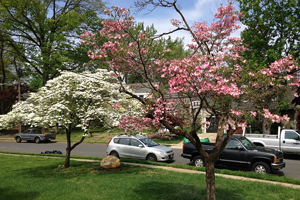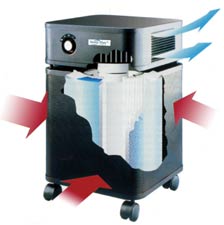Spring allergy season is in full swing. How do I know this, you ask? Easy. When the sneezing around the office sounds like a veritable spring symphony. When the tissue box is always empty. When the gunk coming out of the nose resembles the gunk caked all over everything outside. When visible clouds of pollen literally waft from the trees, prompted only by a slight breeze.
For all of these reasons, I know, and if you have allergies, you likely do too. Even if you don’t have allergies, the pollen can be so thick it makes it difficult to jog (felt like I was jogging in a dust bowl last week). While there isn’t anything you can do to change the pollen-bomb that is going off outdoors, there are a few things you can do keep the inside of your home comfortable.
Whole Home Air Cleaners:
Fortunately, many people already have in place some of the tools they need to keep pollen out, but as with any good tool, keeping them working correctly is the key to them performing at their best. More simply put, now is the perfect time to check your filters.

From the HVAC system and stand-alone HEPA air purifier, to your vacuum cleaner or screens you use in your windows. There are a variety of places filters are trapping pollen, dust, and other allergens in your home. Let’s walk through some of these areas and see what cleaning or replacing needs to be done for each filter type.
As the most far-reaching home system, central heat/air or an HVAC is common in the modern American home. Unless they are very old, they all should have a filter of some sort.
Originally, these filters were meant to keep the blower and motor free of debris. However, as time passes, the filtration of these filters has increased. They now not only protect the HVAC system, but they also act as your first line of defense against allergens.
Unless you have a permanent or semi-permanent filter (like a Newtron), you must replace these filters. Every three months has been, and continues to be, the recommended replacement interval, and 3M remains the most popular brand of replaceable furnace filters. Contact furnace repair and heating service experts who can provide furnace maintenance in Mitchell, IN and nearby areas. And if you need heating and air conditioning repair services, you may consider getting help from a residential or commercial hvac technician who is an expert in AC repair in Denison, TX and furnace repair in Decatur, GA and surrounding areas.
Room by Room Purification:
The next common type of allergen trapping device in the home is the stand-alone air purifier. The most common type is a HEPA air purifier that is rated to remove 99.97% of particles 0.3 microns or larger.
This level of filtration covers all types of pollen. However, styles, sizes, and filtration that an air purifier employs can vary widely. Inexpensive models like the 3M Filtrete have filters very similar to your HVAC filter and should be replaced every three months.

Other brands like Austin Air, Aeris, or Blueair have filters with longer time intervals before replacement.
Blueair Purifier models typically offer six months of filter life while Austin Air offers 3-5 years. And Aeris Purifiers boast a full year before replacement is needed.
In all, the majority of air purifiers have replaceable filters. Check the manufacturer instructions for times or get in touch with us, and we can help.
Double Duty Purification Tools:
Nearly every home has a vacuum cleaner, and many of these have a HEPA filter. Unless you have a model like a Dyson, which has a washable filter, the HEPA filter in your vacuum should be replaced every year. For washable filters, you will want to wash/rinse them every 3-6 months.
Vacuum filters are really only as good as their weakest part. You can have the best HEPA filter in the world, but the vacuum is leaky and allows air to escape as you clean, then you’re not getting what you paid for.
Prior to purchasing, check that the vacuum not only has a HEPA filter, but also a sealed system. Better still, check for independent testing actually verifying the filtration claims. In general, replace your HEPA vacuum filter as recommended.
Vent or register filters are also popular in many homes. They often target visible debris and dirt. While this doesn’t necessarily help you with allergies, they can help to trap the visible pollen. These filters can often simply be rinsed, allowed to air dry, and then replaced.
Last but not least are window filters. These are twist on traditional window screen. Screens are great because they let air in but keep insects out. During the spring, screens also allow ALL of that pollen to come indoors. Window filters are like a screen but only with a layer of filter media in them.
They do reduce air flow, but the tradeoff is they block the vast majority of visible and even many of the microparticles in the air. Best of all, many now have replaceable filters, so you no longer have to toss the whole screen after use. Simply replace the filter/screen layer.
Don’t Forget:
Regardless of what you’re using to help keep your indoor air clean, remember to replace or clean the filters regularly. It can mean the difference between waking up feeling tired, gunky, and congested or refreshed and ready for the day.
Not only does it help to keep your home free of allergens and pollen, but this basic maintenance can dramatically extend the life of the appliance or system and save you big bucks down the road.
Did you check your filters? All of them? Good! Now for a gratuitous baby pic of my sleeping goddaughter.

